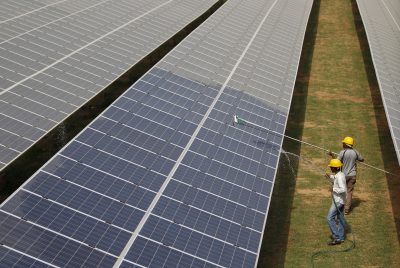Author: Tim Buckley, Institute of Energy Economics and Financial Analysis
The COVID-19 pandemic has changed the world. It is a truly global threat, ignoring national borders and domestic politics. But this pandemic highlights the need for a global response to a second key global threat: climate change. It is now more important than ever to listen to the advice of experts before it’s too late.

Despite the current global economic shutdown, the global energy transition is well underway. This transition is being driven by renewable energy technology that disrupts incumbent industry business models, much like the rise of the mobile phone and the internet.
The technology disruption is fundamentally reshaping the global energy landscape. A key impetus is the dramatic, ongoing deflation in the cost of solar energy and battery storage. Both have seen costs drop 80 to 90 per cent over the last decade and the Institute for Energy Economics and Financial Analysis (IEEFA) expects both to halve again in the coming decade. Renewables are now a cheap source of energy generation, beating the costs of new imported coal.
Such a global market transformation has significant implications for energy security.
India, for example, imported some US$250 billion worth of fossil fuels in 2019, both a massive economic drain and a major energy security risk. Leveraging renewable energy resources — wind, solar and hydro — allows for domestic diversification away from imports and helps reduce energy security risks. India is targeting 450 gigawatts of renewables by 2030.
China has been the world’s largest investor in renewable energy in the last decade. The IEEFA expects Chinese renewables to reach grid parity with coal-fired power nationally in 2020 as capacity expansions drive economies of scale and continuing deflation.
While South and Southeast Asia have been renewables laggards, Asia is nevertheless on the cusp of a dramatic pivot. Recent developments across India, China, Japan, South Korea, Vietnam and Taiwan highlight the potential for change.
Back in 2016–17, India’s then Energy Minister Piyush Goyal accelerated the use of online reverse auction tenders for the supply of renewable energy for a term of 25 years with zero indexation, backed by bankable central government contracts.
The result was staggering.
In one year, the price of tariffs dropped by 50 per cent to below Rs 3 per kilowatt-hour (US$40 per megawatt hour). This price was 30 per cent below the cost of existing domestic thermal generation and 50 per cent below new imported thermal power. Since then, India has taken advantage of global investor interest to invest US$10 billion annually in renewable infrastructure.
In the last decade, India has scrapped plans to build 600 gigawatts of new coal-fired power plants, including 46 gigawatts in 2019 alone. Stranded asset losses in the Indian thermal power sector have reached US$60 billion.
This promise of low-cost, domestic, zero-emissions renewable energy is yet to be realised in Southeast Asia. But this will change dramatically, with finance playing a key role.
In the first half of the last decade, global financial giants provided the bulk of debt and equity capital for investment in new coal-fired power plants across Asia. But the global investor push to align with the Paris Agreement has seen coal jettisoned as the most carbon-intensive fuel source and the one easiest to replace. As of today, 129 globally significant financial institutions have formal coal divestment or exclusion policies.
But coal financing is not totally out of fashion yet. In the last five years, government-owned export credit agencies (ECA) of just three countries — China, Japan and South Korea — funded the majority of the world’s new coal-fired power plants.
In 2016–17, China was ‘Going Global’. An IEEFA report in January 2019 revealed Chinese financial institutions had committed US$36 billion for over one-quarter of the 399 gigawatts of coal plants currently under development outside China. Most of the power projects span Asia, from Pakistan to Bangladesh to Vietnam.
But with the energy disruption accelerating globally, the US–China trade war and COVID-19 have massively impacted coal financing.
One analysis demonstrates this dramatic change when looking at China’s commitment to its Belt and Road Initiative. China’s outbound ECA finance for power generation dropped by two-thirds in 2018 from a peak of US$18 billion in 2017 and then dropped again in 2019 to a decade low of just US$2 billion.
Japan has been pivoting away from coal, with the government renewing its commitment to the Paris Agreement. This started in 2018 with a global appeal by Prime Minister Shinzo Abe to recognise the disastrous implications of climate change. This was followed by a slowly accelerating exit from thermal coal mining by most Japanese trading houses and financial institutions.
South Korea is also on the move. In April 2020 the ruling Democratic Party won a landslide victory on the back of an announced plan for a Green New Deal, starting with a cessation of global coal financing.
The world’s three largest subsidisers of coal plants are all getting cold feet. The cost and financial risks of continuing to provide subsidised capital for projects are now threatened by cheaper alternatives.
Vietnam’s government announced last month a dramatic reduction in its coal-fired power plant development plans, pivoting towards a greater focus on wind and solar. Vietnam shocked the world in 2019 when it expanded solar capacity 10-fold in one single year.
Taiwan has been a regional leader on climate policy, with plans to roll out 27 gigawatts of renewables to supply 20 per cent of total electricity needs by 2025. Taiwan is also expanding its offshore wind projects, which could progress plans for 100 gigawatts of new offshore wind capacity in Asia.
The global energy transformation is belatedly coming to Asia. The speed of that change is likely to be dramatic and consistent with disruptions seen in Europe, the United States, Australia and India over the last five years.
Tim Buckley is Director of Energy Finance Studies, South Asia, at the Institute of Energy Economics and Financial Analysis (IEEFA), Sydney.
Courtesy:East Asia Forum
Comments